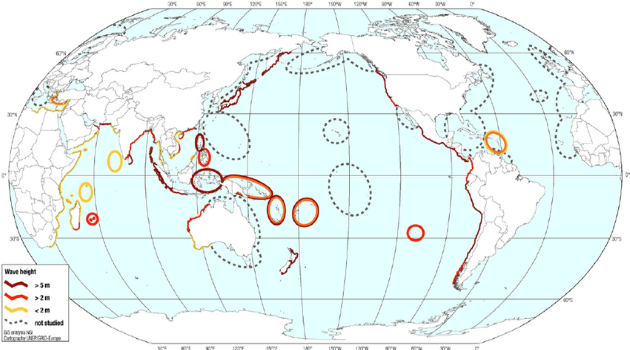The destructive nature of tsunami was clearly illustrated by two large events in the early 21st century: the 2004 Indian Ocean tsunami (with more than 225 000 fatalities and almost 10 billion dollars in damage) and the 2011 Tohoku tsunami in Japan (with more than 19 800 fatalities and 210 billion dollars in damage). Such events cause massive casualties, economic losses, and damages to critical infrastructure, but they are also infrequent, with recurrence times typically ranging from hundreds to thousands of years. Therefore, historical records often do not include events as destructive as those we need to be prepared for. As a result, many coastal communities are not always well prepared for such large tsunamis and may underestimate the hazard, as demonstrated in the above mentioned events.
Tsunami hazard models that provide probabilities of infrequent tsunamis are necessary because many regions exposed to tsunamis have little memory of past events. Making assumptions on future tsunami sources based on our best scientific knowledge and modeling the ensuing tsunamis are therefore an initial and essential component of comprehensive disaster risk management strategies that can complement the sparse historical record. Simulations of potential tsunamis and subsequent vulnerability and risk assessments play a key role in the design of risk reduction measures for both the pre- and post-event stages, such as education and raising risk awareness, building requirements, evacuation planning, drills, emergency plans, potential damage analysis, physical mitigation measures, and financial instruments to manage the risks posed by rare, destructive tsunami events.
In the last decade there has been a growing effort to understand tsunami hazard and risk at local, regional, and global scales, with a sequence of increasingly elaborate global tsunami hazard and risk studies, conducted in part through the United Nations Office for Disaster Risk Reduction (UNISDR) biennial Global Assessment Reports (2009, 2011, 2013, and 2015). Most recent iterations of this work incorporate a fully probabilistic approach and have global coverage for the hazard, while further developments are ongoing (Figure 1, above). The results of the 2015 assessment, both for hazard and physical risk, in terms of economic losses, are openly and freely available to the public at risk.preventionweb.net.
Because of the simplifications necessary when working at the global scale, the current global tsunami-hazard and risk models are not recommended for detailed local-scale planning. However, they can give a first-pass estimate of the global distribution of tsunami hazard, which can help to identify exposed regions where in many cases no hazard information previously existed and hence raise the awareness of communities potentially affected. The global models can also be used to help prioritize sites for local scale assessment, to compare the tsunami hazard and risk with those associated to other types of natural hazards, and to provide input as well as useful cross-checks of more detailed studies.
To further improve the quality and to standardize tsunami hazard and risk models, tsunami scientists affiliated to research and academic organizations around the globe have recently convened around a new and scientifically/administratively ambitious initiative called the Global Tsunami Model (GTM). The GTM overall vision and goals are to collaboratively achieve a thorough understanding of the tsunami hazard and risk, together with the processes that drive them. Data, software and standards developed by GTM can be used to underpin and facilitate national and local-scale tsunami hazard and risk assessments. These goals are closely related to the priorities included in the Sendai Framework of Disaster Risk Reduction about understanding disaster risk.
The year of the first World Tsunami Awareness Day coincides with the beginning of the GTM. It is expected that, in the years that follow, relevant findings can be provided by this new initiative, always having in mind the goal of reducing the impact of these extreme events, saving lives, and providing a well-founded basis for the development of effective risk reduction measures.

